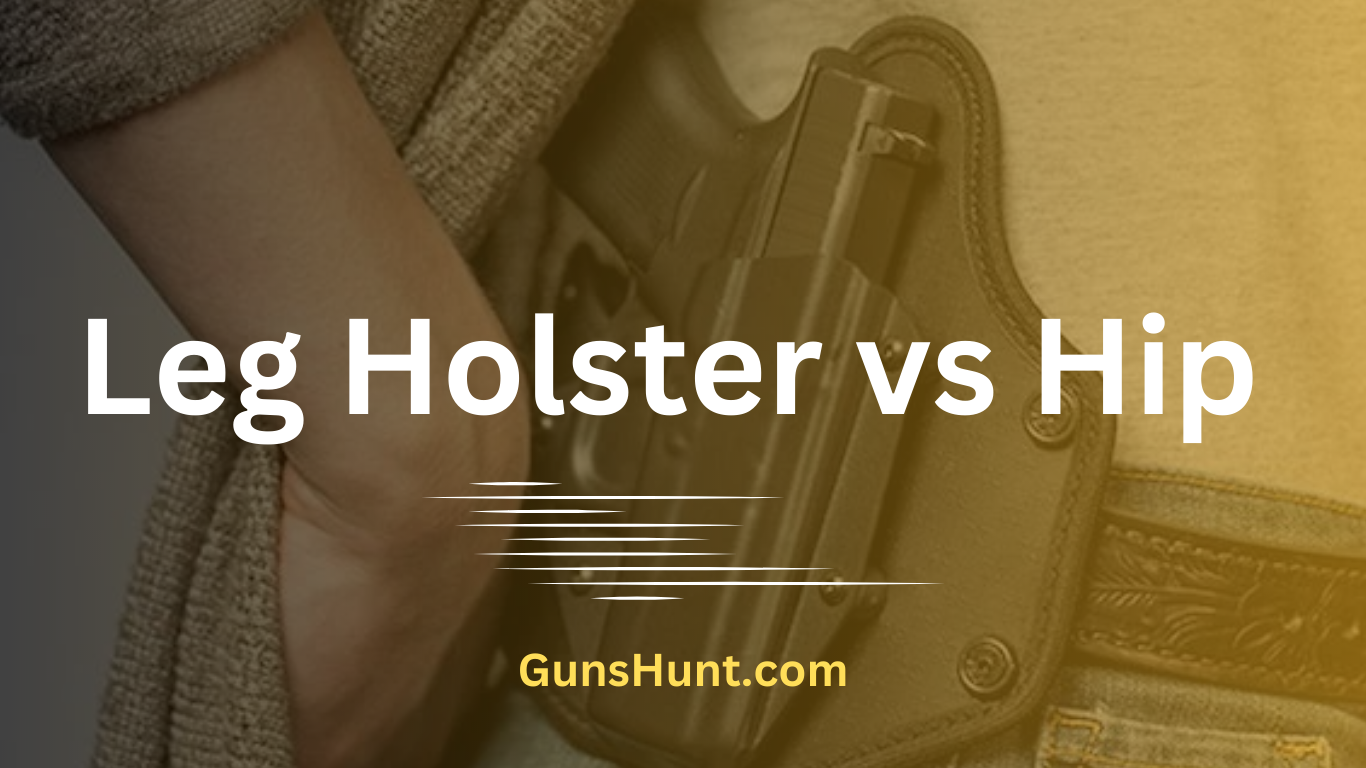In the United States, where the right to bear arms is constitutionally protected, the way you carry your firearm is more than just a matter of personal preference—it can be a crucial factor in self-defense, law enforcement, and sport shooting.
When considering options like leg holsters and hip holsters, individuals often weigh various elements such as convenience, weight distribution, and accessibility.

Both law enforcement professionals and civilians face a common question: Is it better to have your sidearm at your hip or strapped to your leg?
This article aims to provide an in-depth comparison between leg holsters and hip holsters, focusing on several key factors.
Among them, we’ll discuss how each impacts your torso and waist, the convenience of drawing your weapon with your hand, and how these holsters interact with other elements like a police duty belt.
Whether you’re a police officer tasked with maintaining law and order, or a civilian concerned about personal safety, understanding the pros and cons of these holster types will help you make an informed decision about how best to carry your firearm.
Overview of Leg Holster
The leg holster is an integral part of the toolkit for many in law enforcement, emergency services, and national security.
Designed to hold a handgun securely around the upper thigh, it often includes straps that connect to a belt for added stability.
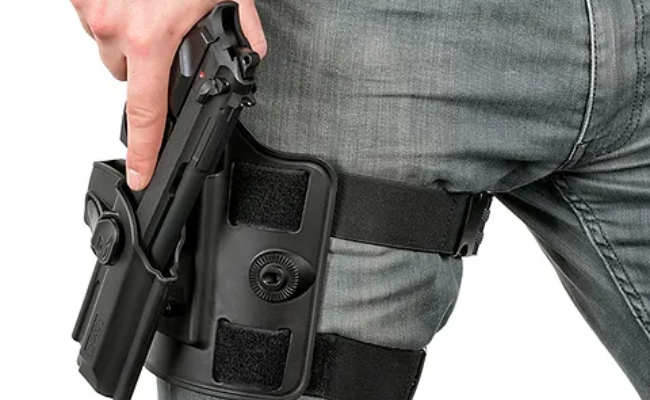
The placement on the leg allows for quick and easy access to the weapon, a crucial advantage in high-stakes situations where every second counts, such as crime prevention or emergency response.
Although they might seem like they could interfere with other equipment, many leg holsters are actually designed to work in tandem with police duty belts and other pieces of military technology.
This design consideration makes them versatile options for professionals who must carry various types of equipment for public safety and emergency management.
In terms of legality, the use of leg holsters is usually permitted in areas where open carry or concealed carry is legal.
Nonetheless, it’s vital to remain up-to-date on both local and federal laws concerning weapon storage and access, as legal action can be taken for improper use.
Issues of ethics and safety are also closely tied to the use of leg holsters. Proper training is essential to minimize risks during the quick draw and re-holstering of the weapon.
The misuse of a holster could not only put the user at risk but also has broader implications for public safety, criminal justice, and even the political landscape surrounding weapon carry laws.
Thanks to advancements in military science and technology, modern leg holsters are manufactured from durable materials like reinforced polymers and ballistic nylon, ensuring that they can withstand the wear and tear of intense usage.
Pros:
- Quick and easy access to the weapon, crucial for emergency situations.
- Compatibility with other equipment such as police duty belts, making them versatile for various roles.
- Straps that attach to a belt offer increased stability and security, ensuring the weapon remains in place.
- Modern leg holsters are often made from durable materials like reinforced polymers, capable of withstanding wear and tear.
- Legally accepted in many jurisdictions where open or concealed carry is allowed, making them a viable option.
Cons:
- Requires specific training to minimize risks associated with quick drawing and re-holstering.
- Despite being designed for compatibility, they can sometimes interfere with other equipment.
- The position on the leg may affect the distribution of weight, potentially leading to discomfort over extended periods.
Overview of Hip Holster
The hip holster is another widely used option for carrying a firearm, both in professional settings like law enforcement and for civilian use.
Positioned around the waist or on the belt, these holsters offer a more traditional way to carry a sidearm. The design aims to provide easy access to the weapon while still allowing for freedom of movement.
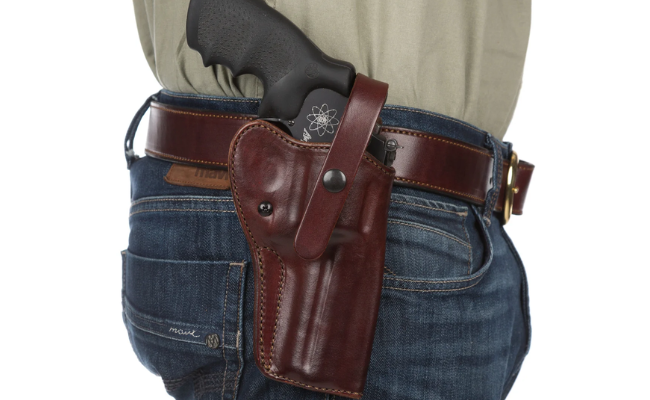
Hip holsters are often integrated into a police duty belt, making them a standard issue in many law enforcement agencies.
They are designed to be compatible with other essential pieces of equipment and are generally considered to be stable due to their attachment at the waist level. This positioning also allows for a balanced distribution of weight, reducing the risk of discomfort or injury.
From a legal perspective, hip holsters are generally accepted in areas where open or concealed carry is permitted. Just like leg holsters, it’s essential to remain current on both local and federal laws related to weapon carry and storage.
Safety concerns also extend to the use of hip holsters. Proper training is vital for effective and secure use, especially when drawing and re-holstering the weapon quickly.
Misuse could not only put the user at risk but has broader implications for public safety and the legal system.
Advancements in technology have made modern hip holsters more versatile and robust. Manufactured from materials like polymer or reinforced leather, they are designed to withstand the demands of intense usage.
Pros:
- Convenient access to the firearm while maintaining ease of movement, making it useful in various scenarios.
- Often integrated into a police duty belt, which enhances its compatibility with other equipment.
- Positioned at the waist for balanced weight distribution, reducing the risk of discomfort or injury.
- Widely accepted from a legal standpoint in areas where open or concealed carry is permitted.
- Made from durable materials like polymer or reinforced leather, which can withstand intense usage.
Cons:
- Proper training is essential for safe drawing and re-holstering, making misuse a potential risk.
- May not be as quick to draw from compared to leg holsters, depending on body positioning and clothing.
- Can interfere with the natural arm swing during walking or running, potentially causing discomfort over time.
Leg Holster vs. Hip Holster: Which one is better?
Design and Aesthetics:
When it comes to carrying a firearm, design and aesthetics often play a crucial role. Leg holsters offer a more tactical appearance, often seen in action movies and military applications.
Hip holsters, on the other hand, provide a traditional look that many associate with law enforcement and classic Western films.
The design of leg holsters is generally more intricate, with additional straps for secure attachment. This makes the holster visually more imposing but also more practical in certain high-stakes situations. Hip holsters are typically simpler, attaching directly to the belt or waistline.
Materials used in the construction of these holsters can vary but often include reinforced polymers and ballistic nylon for leg holsters, and leather or polymer for hip holsters. The choice of material can impact both aesthetics and functionality, including weight and comfort.
Leg holsters usually allow for more customization. Extra pockets for magazines or a flashlight are not uncommon, providing a versatile setup.
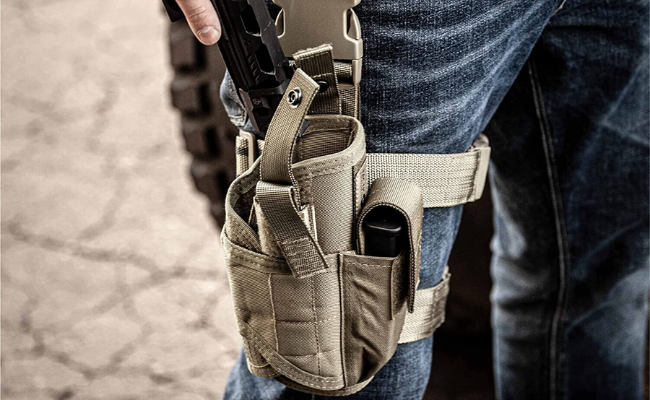
Hip holsters are generally less customizable but may offer different methods of retention, like thumb breaks or retention screws.
In the fashion sense, hip holsters often blend in more effortlessly with daily attire, especially for concealed carry. Leg holsters, however, can be more conspicuous and may not be suitable for every dress code.
Drawing and Re-holstering
The speed and ease of drawing a weapon can be a defining factor in critical situations. Leg holsters offer quick access, especially when the user is in motion or seated. The location on the upper thigh makes it straightforward to reach down and draw the firearm.
Hip holsters, being at the waist level, offer convenient access but can be slightly slower to draw from when sitting down or in constrained positions. This can be a point to consider for those who spend a lot of time seated, like vehicle patrols or desk jobs.
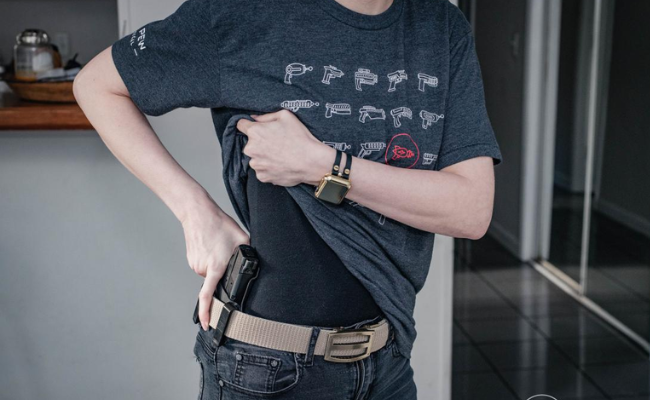
Reholstering is generally easier with hip holsters due to their more rigid structure. The opening tends to remain unobstructed, facilitating a safer and quicker return of the weapon. Leg holsters can sometimes require two hands to re-holster, depending on design and material.
For those concerned about accidental discharges, the location of hip holsters at waist level often makes it easier to ensure the muzzle direction is safe while drawing or re-holstering. Leg holsters require more attention to muzzle discipline, especially in high-stress situations.
In summary, leg holsters excel in quick draw scenarios, particularly while on the move. Hip holsters offer advantages in re-holstering and may be safer concerning muzzle direction.
Comfort and Long-Term Wear
For law enforcement officers, security personnel, and individuals concerned about personal safety, the comfort and long-term wear of a holster are paramount.
Leg holsters, often strapped to the thigh and linked to a belt, can cause weight distribution issues over extended periods. This can lead to discomfort and even injury, a significant concern for occupational safety and health.
Hip holsters, commonly integrated into a police duty belt, tend to offer a more balanced weight distribution around the waist.
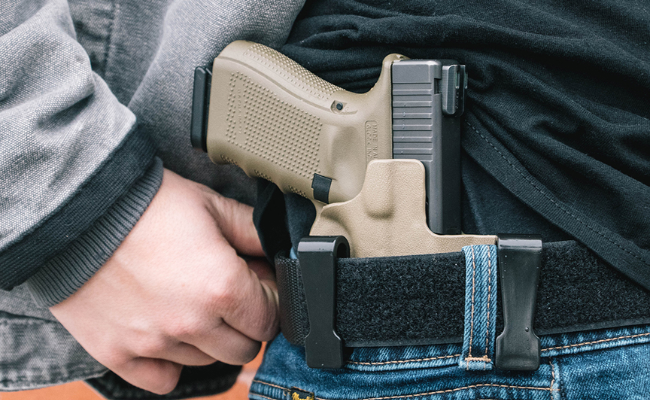
This is crucial for law enforcement, emergency services, and even military personnel who wear their holsters throughout long shifts. The waist-based design can minimize the risk of discomfort and potential hazards associated with improper weight distribution.
For the public sphere, especially those interested in carrying a firearm for personal safety, comfort is also a significant factor.
Hip holsters usually blend more naturally with civilian clothing, making them easier to wear for extended periods. The challenge with leg holsters is that they can be more conspicuous, making them less ideal for day-to-day wear.
Both leg and hip holsters are subject to various government regulations and laws, impacting their wear and usage. Following legal action or changes in law can result in restrictions on how and where these holsters can be worn, which could affect comfort and practicality.
National security personnel, dealing with different risks and hazards, may also find hip holsters more convenient for long-term wear due to their balanced weight distribution.
This plays a significant role in minimizing risks and ensuring optimal performance during extended operations.
Compatibility and Integration with Other Equipment
In today’s world where law enforcement and military technology have advanced considerably, the compatibility of a holster with other equipment is more crucial than ever.
Leg holsters often offer extra pockets for ammunition, flashlights, and other essential tools. This makes them more versatile but can also create problems with weight and balance, especially if poorly integrated with a police duty belt or other standard issue equipment.
Hip holsters often feature designs that integrate seamlessly with a standard police duty belt. This means they can be part of an established system of equipment, optimizing operational effectiveness for law enforcement agencies and emergency management services.
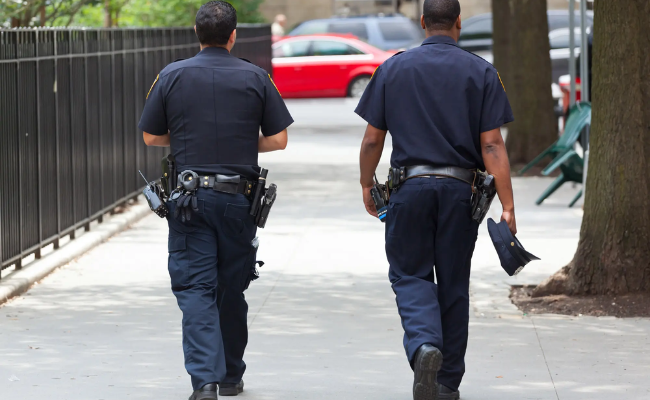
For those involved in national security or even private security firms, the integration of hip holsters into an existing setup can be more straightforward.
The concerns are not just about physical equipment but extend to legal considerations as well. Both types of holsters are subject to laws and regulations that can vary widely, not just on a federal level but sometimes even at the state or local level.
Understanding these laws is crucial for law enforcement agencies, security services, and even civilians.
For those in specialized sectors like forensic science or those concerned with issues in ethics and public policy, the choice of holster can be influenced by its compatibility with other technology or tools.
For example, some holsters are designed to prevent unauthorized access to the weapon, a feature that can be vital in specific law enforcement scenarios or for personal defense.
Given the wide range of applications, from law enforcement techniques to civil defense and even international security, compatibility and integration are not just about the holster.
They are about how the holster fits into a broader system of tools, equipment, and regulations, affecting everything from individual safety to public law.
Durability and Material
One of the most critical factors to consider when choosing a holster is the durability and material used in its construction.
Leg holsters, often made from tough ballistic nylon or reinforced polymers, are designed for rugged use. They need to withstand various environmental conditions, from the high-stress situations faced by law enforcement to the risks and hazards encountered in military operations.
Hip holsters, usually constructed from leather or polymer materials, are also designed for durability but in a different context.
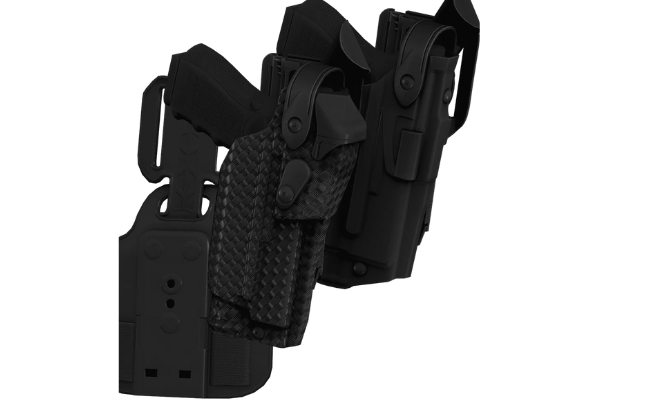
For police and emergency services, the holster must be resilient enough to withstand the daily grind of patrolling, arrests, and other law enforcement techniques. Leather hip holsters offer a classic look but may require more maintenance to preserve their condition.
For those involved in national security or military science, the requirements for durability might differ. Hip holsters, given their more streamlined design, may not offer the kind of wear and tear resistance required for intensive field operations.
Conversely, the robust nature of most leg holsters makes them suitable for these high-stakes environments.
Manufactured goods like holsters are often subject to strict quality control, particularly when they are part of government or law enforcement equipment.
Durability isn’t just about the material; it also relates to how well the holster holds up under repetitive drawing and re-holstering of the weapon. This has implications not just for the individual user but also for broader issues in public safety and crime prevention.
Public opinion may also play a role in the choice of material and durability. For instance, ethical principles regarding the use of animal products may make leather holsters less popular among some groups.
On the other hand, the use of advanced polymers and technology in leg holsters might appeal to those looking for a modern and efficient carrying solution.
Public Opinion and Cultural Factors: From Hollywood to the Public Sphere
Holsters are not just practical equipment; they’re also deeply embedded in American culture and traditions. Leg holsters often conjure images of special forces or action heroes, partly due to their portrayal in entertainment mediums like movies and video games.
This has a palpable effect on how they are perceived by the public, potentially affecting their acceptance and usage.
Hip holsters carry their own set of cultural implications. They are often seen as the standard for police and have a long history in classic Western films.
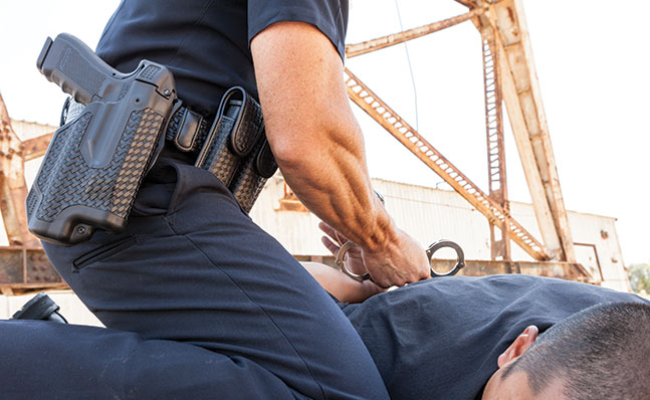
This gives them a sense of tradition and continuity, making them more palatable for daily wear, both for law enforcement and civilians.
Public opinion about holsters can often be influenced by current events, particularly those involving gun politics and law.
High-profile incidents involving firearms may lead to public policy changes or even legal action affecting holster usage.
This makes understanding the cultural and social dynamics surrounding holsters essential for anyone involved in law enforcement, security, or even individual gun ownership.
Why are drop leg holsters bad?
Drop leg holsters, also known as thigh holsters, have their share of criticisms and drawbacks, especially when compared to other types of holsters like hip or waistband holsters.
Here are some reasons why some people consider drop leg holsters to be less effective or potentially problematic:
- Accessibility and Drawing Speed: Drop leg holsters sit lower on the thigh, which can make the weapon harder to access quickly. In high-stress or emergency situations where law enforcement officers or civilians may need to draw their sidearm promptly, those few extra moments could be crucial.
- Restricted Mobility: The holster’s positioning can interfere with natural leg movement, impacting activities like running or kneeling. This can be a significant issue for police officers, military personnel, or others who need to move quickly as part of their job.
- Weight Distribution: A leg holster can make the firearm feel heavier due to its positioning away from the body’s core. This can be cumbersome and can throw off an individual’s balance, particularly if they are also carrying additional ammunition or equipment.
- Potential for Injury: Because of the weight and positioning, there’s a higher risk of chafing, bruising, or even more severe injuries if the person falls or is engaged in physical combat. Occupational safety and health considerations come into play here, particularly for those in law enforcement or military roles.
- Visibility: Drop leg holsters are more conspicuous than waistband or hip holsters. This can be a disadvantage in situations where discretion is required, potentially drawing unwanted attention to the weapon and the individual carrying it.
- Strap Security: The straps of a drop leg holster can loosen over time or due to vigorous activity, causing the holster to sag or twist. This creates issues with weapon security and can also lead to an awkward drawing angle, which may affect marksmanship and overall performance.
- Laws and Regulations: In some jurisdictions, the visible carrying of firearms can be subject to legal restrictions, and a drop leg holster certainly makes the firearm more visible. Ignorance of these laws can result in legal repercussions.
- Cultural and Social Perception: Given their more “militaristic” look, drop leg holsters might not be as readily accepted in civilian settings or even among certain law enforcement agencies. Public opinion on what is considered “acceptable” for everyday carry can influence the practicality of using a leg holster.
While drop leg holsters are not universally “bad,” they come with specific drawbacks that can make them less suitable for certain users and situations.
Conclusion
drop leg holsters have their particular sets of drawbacks that can make them less suitable for certain situations and individuals.
Issues ranging from accessibility challenges, especially in confined spaces or while seated, to problematic weight distribution can pose operational limitations.
While they might be appropriate for specific tactical scenarios, such as military operations where quick movement is less critical, these holsters are often not the best choice for law enforcement or civilian use where agility, comfort, and quick access to the weapon are paramount.

